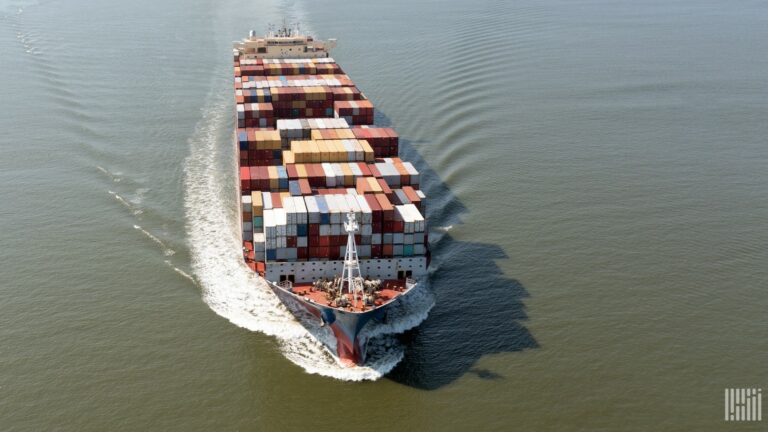Container shipping spot rates still falling: What will be the new normal?

Which of these two is happier? Someone who wins $3 million in the lottery then blows $2 million in Vegas, or someone who wins $1 million in the lottery and puts it in the bank?
Containerized cargo shippers face the reverse emotional scenario. Who’s less upset if spot rates quintuple? A shipper who’s used to paying $1,500 per forty-foot equivalent unit and suddenly sees rates jump to $7,500? Or one who pays $1,500 per FEU for years, gets slammed with crippling rates of $20,000 per FEU including premium charges, then gets “relief” as rates slide all the way back down to $7,500?
No one believed $20,000-per-FEU spot rates in fall 2021 were sustainable. If rates stayed that stratospheric for too long, it would destroy transport demand and compel competition regulators to step in. As Hapag-Lloyd CEO Rolf Habben Jansen said during a conference call in November, “It would be better for everybody if we saw more normalization.”
That process is now underway. But what will be the new normal?
The best-case scenario for shipping lines is for the COVID rate surge to have emotionally and financially acclimated customers to higher freight costs, and for rates to stabilize at levels high enough to generate strong and sustainable profits for ocean carriers, but not so high that competition authorities intervene. For shippers, this new normal for rates would be much higher than pre-COVID levels but might seem like a bargain compared to all-time peaks.
Drewry’s weekly assessment for Shanghai-to-Los Angeles spot rates came in at $7,480 per FEU on Thursday. That’s down 23% year on year and down 1% week on week. This assessment is now 40% below its peak of $12,424 per FEU in late November 2021, yet still 5.3 times higher than rates at this time of year in 2019.
Drewry’s weekly spot assessment for Shanghai-to-New York was at $10,164 per FEU, flat week on week, down 14% year on year, down 37% from the peak of $16,183 per FEU in mid-September — but still quadruple 2019 levels.

Weekly spot rate assessment in $ per FEU. Blue line: Shanghai to LA. Green line: Shanghai to NY. Chart: FreightWaves SONAR
On one hand, a sharp drop in rates over the past nine months is reducing costs for shippers (at least, compared to last fall) and is showing that the market is functioning: Ocean carriers are competing on price to fill slots. On the other hand, rates are still very profitable to ocean carriers and transport costs for shippers are still dramatically higher than they were pre-COVID.
Different indexes show different numbers but the same trends.
The Freightos Baltic Daily Index (FBX) China/East Asia-to-North America West Coast assessment was at $7,264 per FEU on Thursday, down 65% from the all-time high of $20,586 per FEU in September but still five times more than rates at this time of year in 2019.
The FBX China/East Asia-to-North America East Coast rate was $10,020 on Thursday, less than half its all-time high of $22,234 per FEU in September but more than triple pre-COVID levels.

Daily spot rate assessment in $ per FEU. Blue line: China/East Asia to North America West Coast. Green line: China/East Asia to North America East Coast. Chart: FreightWaves SONAR
The drop from the peak is much steeper for the Freightos trans-Pacific indexes than for Drewry and other index providers because Freightos began including premium charges in its assessment methodology starting July 28, 2021.
Space has now opened up and shippers are generally no longer paying premiums.
Dafna Farkas, corporate marketing associate at Freightos, told American Shipper: “In the peak of the COVID surge, we ensured that the all-in rates were reflected by including premiums. We continue to ensure that all-in rates are reflected in the index and in that [regard], have not changed the methodology. On a price-point level, since premiums have largely been eradicated due to industry normalization, they aren’t really reflected in the industry price.”
S&P Global Commodities (formerly Platts) assessed North Asia-to-North America West Coast Freight All Kinds (FAK) rates at $7,100 per day on Thursday. That’s down 25% from the peak but still 4.3 times 2019 levels.
S&P Global put North Asia-to-North America East Coast FAK rates at $9,700 per day, down 19% from the all-time high albeit 3.5 times mid-July 2019 levels.
The container shipping team at S&P Global has been reporting lower-than-expected Asia-U.S. demand ever since the end of the Chinese New Year holiday in February.
Downward spot-rate pressure continues, S&P Global said this week, given ample space availability out of China and smaller carriers with chartered tonnage undercutting freight pricing of larger mainline carriers (in other words: competition). Some North Asia-to-West Coast spot offers were below $7,000 per FEU, it reported.
George Griffiths, managing editor of global container freight at S&P Global Commodity Insights, told American Shipper: “The market is just in wait-and-see mode at the moment. There are rumors of more lockdowns in Shanghai coming up, and some concerns that delays across the U.S. East Coast will begin to spread to the West Coast once more, but nothing concrete.
“High inventory levels and the rising cost of living are keeping a natural lid on demand at this point. So, the atmosphere is rather bearish, only being helped by the void [canceled] sailings that carriers are bringing in to try and protect rates.”
Read also
Wheat in Southern Brazil Impacted by Dry Weather and Frosts
Oilseed Industry. Leaders and Strategies in the Times of a Great Change
Black Sea & Danube Region: Oilseed and Vegoil Markets Within Ongoing Transfor...
Serbia. The drought will cause extremely high losses for farmers this year
2023/24 Safrinha Corn in Brazil 91% Harvested
Write to us
Our manager will contact you soon



